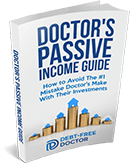The Hidden Retirement Gap Keeping High-Income Earners Stuck
Are You Earning a Great Income… But Still Feel Trapped?
You’re making $300K… $500K… maybe even $700K a year. But deep down, you know something’s off.
Why does it still feel like you can’t slow down?
Why does the idea of stopping work early seem impossible?
If that sounds like you, this article will explain the real reason so many successful professionals—especially doctors and dentists—stay stuck in the grind far longer than they want to. It’s not your fault. You were simply handed a playbook that was never built for true freedom.
Rather watch the full breakdown?
Don’t Miss Any Updates. Each week I’ll send you advice on how to reach financial independence with passive income from real estate.
Sign up for my newsletterThe Retirement Plan You Were Sold Is Broken
Most high-income professionals follow the same path:
Work hard. Max out your 401(k). Defer taxes. Keep grinding. Retire at 65.
Sounds responsible, right?
But here’s the catch: you can’t touch that 401(k) until you’re nearly 60, and even then, the income you pull is taxable. Meanwhile, you’re still trading your most valuable resource—your time—for money.
No one talks about what happens in between those milestones. That’s where the trap lies.
Real Stories From the Grind
Let me introduce you to two people I’ve worked with—both high earners, both stuck in different ways.
Dr. James: Surgeon in Dallas
At 44 years old, he’s earning $700K a year. He lives in a beautiful $1.2M home, drives a Porsche, and vacations in Europe. On paper, he’s winning.
But behind the scenes, he’s exhausted and feels stuck. His words?
“I make too much to quit, but not enough to stop.”
He’s saved over $2 million—but it’s all locked away in retirement accounts he can’t access for 15 more years. He wants out in 10 but has no idea how to fund the years in between.
Dr. Mark: Dentist in Arkansas
He’s 52, his practice is paid off, and he’s making around $450K a year. He has $1.3M saved in retirement and about $250K in a brokerage account.
But back pain, wrist pain, staffing headaches, and tuition for two kids in college are wearing him down. He doesn’t want to fully retire—he just wants the option to slow down.
But again, his income is tied to showing up at the office.
He told me: “I don’t know how to cut back without cutting off my income.”
The Retirement Gap No One Warned You About
Here’s the truth: you’ve been following someone else’s plan.
The idea that retirement starts at 60 or 65 didn’t come from people who wanted you to be free—it came from financial institutions who profit when you keep your money locked up for decades.
But what about the years before that? The time when you still have energy, dreams, and maybe kids at home? That period between when you want to stop and when you’re allowed to access your money is called:
The Retirement Gap.
And if you don’t plan for it, you’re stuck working longer than you need to.
Why High Net Worth ≠ Freedom
Even with $2 million in retirement savings, you might still feel broke.
Why?
Because you can’t touch it without penalty. And even if you could, pulling it out means paying taxes. On top of that, you still have to worry:
-
Will the stock market be up or down when I need the money?
-
What if I run out?
-
What if I get burned out before I can even enjoy it?
That’s not financial freedom. That’s financial stress.
The Freedom Strategy: Bridge the Gap
If you want work to become optional before 60, you don’t need more net worth.
You need more income now.
Specifically, cash-flowing income that doesn’t require you to trade your time.
Here are two simple strategies I’m using personally—and that many high-income earners are using to break free:
1. Passive Real Estate Syndications
Syndications are group investments in income-producing properties like mobile home parks and RV parks. You don’t manage tenants. You don’t fix toilets. You just invest, and the deal sponsors handle the rest.
They typically pay monthly or quarterly income, and they come with major tax advantages.
Best of all, this income can replace a portion—or all—of your active income.
Related: What Is Real Estate Syndication? A Beginner’s Guide
2. Dividend-Paying ETFs
Instead of relying on stock appreciation or selling off your funds later, I’ve started shifting parts of my portfolio into ETFs that focus on monthly cash flow.
Some that I’ve personally looked into include:
-
Charles Schwab’s Dividend ETFs
-
NEOS funds like SPYI and QQQI
They’re simple, consistent, and still provide market exposure.
I’m not saying these are right for everyone—do your own research—but if you’re sitting on a ton of money in low-dividend index funds, it might be time to consider reallocating for cash flow.
Here’s a cool interview about how you can build an “Income factory” from dividends to fund your retirement:
How to Build Monthly Income with Steven Bavaria’s Income Factory
Why This Matters Now (Not Later)
Waiting until “someday” means living in fear of running out.
What if instead, you started building income that bought you options now?
You don’t have to quit your job. You don’t have to retire early.
But what if you could?
What if you had the freedom to take a step back, slow down, or even walk away—because your income didn’t rely on your time anymore?
That’s the goal.
Final Thoughts
You’re not stuck because you didn’t earn enough.
You’re stuck because your strategy didn’t give you access to the income you need today.
It’s not too late. Even if you’re in your 40s or 50s, you can still build a bridge across the retirement gap.
Start by shifting your mindset:
From saving for one day… to building income for today.



